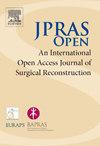游离空肠移植治疗短颈、颈椎病、血管钙化1例。
IF 1.5
Q3 SURGERY
引用次数: 0
摘要
全咽-喉-食管切除术(TPLE)联合游离空肠移植(FJT)是下咽癌的标准重建手术,通常使用甲状腺上动脉作为受体血管。然而,患者特有的解剖变异和合并症会使手术复杂化。我们报告一个68岁男性下咽癌患者的独特病例,他表现出多重挑战,包括身材矮小(126厘米)、体重低(35公斤)、颈椎病和椎体成形术史,突出了这种重建所固有的复杂性。术前化疗后,患者行TPLE及双侧颈部淋巴结清扫术。由于患者颈部较短,颈外动脉钙化严重,选择左颈横动脉(TCA)进行血管吻合。采集空肠段,使用吲哚菁绿(ICG)荧光成像精确修剪以优化血流。手术顺利完成,无并发症。患者术后2周恢复口服,术后1个月出院。随后给予辅助放疗和化疗。在六个月的随访中,没有肿瘤复发的迹象,患者保持软食饮食。本病例证明了TCA和ICG荧光成像在FJT中应用于复杂颈椎解剖结构患者的有效性。这种方法有可能预防严重的并发症,如继发于脊髓病的四肢瘫痪。据我们所知,这是第一个报道的病例,详细介绍了这种复杂的重建,在一个病人提出了这种特殊的解剖挑战星座。我们的发现为处理困难的头颈部重建手术提供了有价值的见解。本文章由计算机程序翻译,如有差异,请以英文原文为准。
Free jejunal transplantation in a patient with short neck, cervical spondylosis, and vascular calcification: A case report
Total pharyngo-laryngo-esophagectomy (TPLE) with free jejunal transplantation (FJT) is the standard reconstructive procedure for hypopharyngeal cancer, typically utilizing the superior thyroid artery as the recipient vessel. However, patient-specific anatomical variations and comorbidities can significantly complicate this surgery. We present a unique case of a 68-year-old male with hypopharyngeal cancer who exhibited multiple challenges, including short stature (126 cm), low weight (35 kg), cervical spondylosis, and a history of vertebroplasty, highlighting the complexities inherent in such reconstructions.
Following preoperative chemotherapy, the patient underwent TPLE and bilateral neck lymph node dissection. Due to the patient's short neck and severe calcification of the external carotid artery, the left transverse cervical artery (TCA) was selected for vascular anastomosis. A jejunal segment was harvested and precisely trimmed using indocyanine green (ICG) fluorescence imaging to optimize blood flow.
The procedure was successfully completed without complications. The patient resumed oral intake two weeks postoperatively and was discharged one month after surgery. Adjuvant radiation and chemotherapy were subsequently administered. At the six-month follow-up, there was no evidence of tumor recurrence, and the patient maintained a soft food diet.
This case demonstrates the effectiveness of employing the TCA and ICG fluorescence imaging in FJT for patients with complex cervical anatomy. This approach holds the potential to prevent severe complications such as tetraplegia secondary to myelopathy. To our knowledge, this is the first reported case detailing such a complex reconstruction in a patient presenting with this specific constellation of anatomical challenges. Our findings offer valuable insights for managing difficult head and neck reconstructive surgeries.
求助全文
通过发布文献求助,成功后即可免费获取论文全文。
去求助
来源期刊

JPRAS Open
Medicine-Surgery
CiteScore
1.60
自引率
0.00%
发文量
89
审稿时长
22 weeks
期刊介绍:
JPRAS Open is an international, open access journal dedicated to publishing case reports, short communications, and full-length articles. JPRAS Open will provide the most current source of information and references in plastic, reconstructive & aesthetic surgery. The Journal is based on the continued need to improve surgical care by providing highlights in general reconstructive surgery; cleft lip, palate and craniofacial surgery; head and neck surgery; skin cancer; breast surgery; hand surgery; lower limb trauma; burns; and aesthetic surgery. The Journal will provide authors with fast publication times.
 求助内容:
求助内容: 应助结果提醒方式:
应助结果提醒方式:


